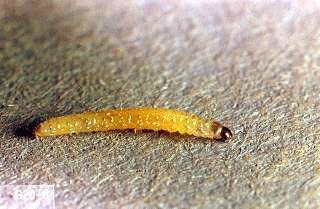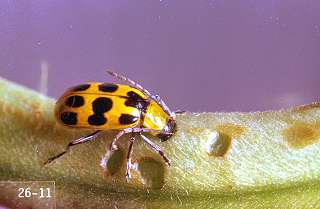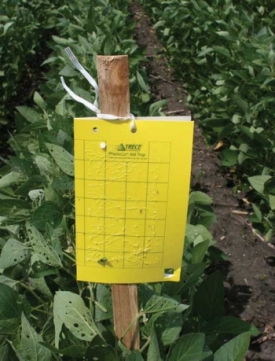Authors: Pamela Opfer and Dan McGrath, OSU Dept. of Horticulture
Western Spotted Cucumber Beetle; 12 Spot Beetle (Diabrotica undecimpunctata undecimpunctata)


12 Spot Beetle larvae 12 Spot Beetle adult (Photos by Ken Gray)
How to ID Pest
The Western Spotted Cucumber Beetle is yellowish green, 1⁄4 inch long, with distinct black spots on its wing covers. Mature larvae are white except for the head and last abdominal segment, which are brown. They are about 5⁄8 inch long.
Lifecycle
There are two generations of beetles per year. It takes 30 to 60 days to complete a life cycle. Cucumber beetles overwinter primarily as fertilized females and become active in early spring. Dispersal flights occur during warm periods in April and May. Adults lay eggs at the base of seedling plants, including sweet corn. Eggs hatch in 7 to 10 days. Larvae feed on roots for about 3 weeks before pupating in the soil. During June, the number of aboveground adult beetles drops significantly. At this point, the beetle population is mostly underground. Adult beetles emerge in 2 weeks, generally in early July, and begin feeding on pollen, plant foliage, flowers, and pods. At this time, grass seed fields are drying down, and the young beetles move into irrigated vegetables. The emergence is marked by a return to a normal male-to-female ratio in the beetle population. The beetle population rises and eventually peaks in mid-August. Beetle populations tend to be relatively high from August through October, when the second summer generation emerges from the soil. This population overwinters and reemerges the following spring.
Below is a graph of twelve spot beetles collected over time during one growing season. During this growing season, the first summer generation peaking in midAugust and the second summer generation peaking in late October. Some, not all, of the second generation of beetles survives the winter and emerge in the spring. Note that the beetle sex ratio is highly skewed toward females. The reason for the sex ratio skew is that that females are larger bodied than the males and are more likely to survive over the winter. There is a brief period of beetle activity in the early spring while female beetles feed, mature, and lay their eggs around the base of emerging sweet corn plants. After depositing their eggs, the female beetles die. At this point, the above ground population essentially disappears. The population (now in the larval stage) goes underground. In early July, the first summer generation matures, forms their pupae, and begin to emerge from the soil. The emergence of the first summer generation is marked by a return by the beetle population to a normal (1;1) sex ratio. In the fall, the second generation emerges and the cycle repeats. The life cycle of the twelve spot beetle has a large impact on our pest control strategies.

Crops Affected & Damage
During the early spring, female beetles damage emerging snap bean seedlings. The beetles focus on snap beans because there is little other green foliage present in the landscape at this time. Adults eat small holes in the leaves and flowers of beans and many other crops.
Early and sometimes intense feeding by the twelve spot beetle on beans is alarming and gives the impression that beetle pressure is very high. However, shortly after this brief period of activity by the female beetles, the above ground beetle population crashes. Thousands of acres of snap beans in the Willamette Valley blossom during the low risk period when above ground beetle populations are very low. Clearly, the most significant damage to snap beans by the twelve spot beetle focuses on the developing bean pods which show up several weeks later. Scouting efforts for twelve spot beetles should concentrate on the week just prior to and during bloom.

12 Spot Beetle damage to beans (Photo by Pamela Opfer)
Scouting & Monitoring
Sweep fields with a standard sweep net just prior to first bloom. Take a minimum of four samples (ten arcs of the net per sample) from different parts of the field. Regardless of the type or absence of neighboring vegetation, beetles tend to concentrate on field edges. By sampling the field edges, the scout puts an appropriate conservative bias on her results.
Be aware of surrounding fields. As grass fields dry down prior to harvest or harvested vegetable crops are disked into the soil, beetles migrate from these areas into irrigated fields, causing a sudden surge in beetle pressure. Swing the net through the crop canopy with the net as deep as possible in the bean canopy. If the crop is short, sweep close to the ground. Try to sample at a consistent time of day, whether morning or afternoon. When the sun is bright and the temperature is high, twelve spot beetles move lower in the bean canopy. It is possible to sweep right over the top of them and get a low bias to your counts. Take note of environmental conditions and consider them when analyzing sweep net results.
Yellow sticky traps are another method to monitor 12 spot beetle populations. Sticky traps are placed just above the crop canopy. Mark the date that you place the trap. Come back in seven to ten days. Calculate the beetles per trap per day.


Using a sweep net in a bean field Yellow sticky trap (Photos by Dan McGrath)
Interpreting Flight Data
If foliage feeding is intense at bean emergence, some growers apply an insecticide at the seedling stage. An action threshold for when to apply insecticide on emerging bean seedlings has not been established in Oregon. There is, however, a sweep net threshold used to determine whether insecticide treatment is necessary at early bloom. If you find an average of 2 to 4 beetles per 10 arcs of the sweep net, treatment is justified. This is a very conservative action threshold used by most growers and industry representatives in the Willamette Valley.
There is not an established an action threshold for insecticide applications based on yellow sticky trap beetle counts. Experience suggests that if counts exceed two beetles per trap per day, treatment usually is justified to protect developing bean pods. A minimum action threshold, however, has not been established for yellow sticky traps. If counts fall below two beetles per trap per day, use sweep net sampling and a sweep net action threshold to make a treatment decision.
Assessing Risk
Use a combination of sweep net sampling, yellow sticky and regional beetle counts to assess risk. Regional beetle population trends are broadcast via VegNet, a newsletter produced by OSU Extension. If regional counts are low, it is a good time to use the sweep net. Sweep net sampling is likely to lead to a no-spray decision. If sweep net counts are low, yellow sticky trap and regional beetle counts are low, there few beetles in the surrounding fields. There are few beetle in the landscape capable of invading the bean planting following a no-spray decision.
However, if sweep net counts in a given bean planting are low, but the yellow sticky trap and regional beetle counts are high, beware. Beetles can invade from surrounding fields following a no-spray decision at first bloom. Plan to return to the field and sweep for beetles the following week. Make sure beetles have not invaded from the surrounding landscape. Generally, once yellow sticky trap counts exceed, on average, two beetle per trap per day, we stop sweep net sampling and plan to apply insecticide at early bloom. This strategy reduces scouting effort and cost. Our rule of thumb is as follows: Black, white, and gray. If it is white (clearly low risk) don’t spray. If it is black (clearly high risk) spray. If it is gray (ambiguous) spray. Using this simple formula has resulted in forty to sixty percent reduction in insecticide applications for twelve spot beetle in snap beans in Oregon.
Control Methods
Biological Control: 12 spot beetles are attacked by a variety of natural enemies, the most important being a parasitic tachinid fly, Celatoria diabroticae. Natural enemies are rarely effective enough, however, to reduce populations below economically damaging levels.
Cultural Control: OSU has conducted a variety of experiments using giant yellow sticky traps, trap crops, and tactics for enhancing and conserving natural enemies. At this point, we are not ready to recommend any of the tested cultural controls as effective in a commercial setting.
Chemical Control: Cucumber beetles are dificult to control. Chemical sprays must be directed at the adult beetle. Please consult the PNW Insect Management Handbook for chemical recommendations.
References & Citations
Hollingsworth, Craig S. (Ed.). 2011. Pacific Northwest Insect Management Handbook. Corvallis: Oregon State University.
Luna, John. "Development of an IPM Program for Western Spotted Cucumber Beetle in Vegetable Cropping Systems." A Report to the Oregon Processed Vegetable growers and the Agricultural Research Foundation. Accessed on December 5, 2011. (http://ir.library.oregonstate.edu/xmlui/bitstream/handle/1957/16581/Luna%2006%20OPVC-ARF%20Report.pdf?sequence=1).
McGrath, Dan, and Ed Peachey. 2006. "Managing 12 Spot Beetles in Snap Beans With Fewer Chemicals and Less Risk of Crop Damage." EM 8906-E. Accessed on December 5, 2011. (http://ir.library.oregonstate.edu/xmlui/bitstream/handle/1957/20435/em8906-e.pdf)
"Western Spotted Cucumber Beetle Factsheet". Oregon State University. Accessed December 9, 2011. (http://insects.ippc.orst.edu/pdf/reb32.pdf).
